- Submissions

Full Text
Trends in Textile Engineering & Fashion Technology
Study on the Causes and Remedies of Ball Formation in Looms due to Improper Sizing
Taposh Ranjan Sarker*, SM Tufazzal Haider, AM Riasat Alam, Salim Ahmed, Sanaullah Murad and Ebrahim Shaikh
1Lecturer, Department of Textile Engineering, Northern University Bangladesh, Bangladesh
2Senior Lecturer, Department of Textile Engineering, Northern University Bangladesh, Bangladesh
*Corresponding author:Taposh Ranjan Sarker, Department of Textile Engineering, Northern University Bangladesh, Bangladesh
Submission: March 23, 2022; Published: July 05, 2022

ISSN 2578-0271 Volume 6 Issue 5
Abstract
Textile industry is a significant source of revenue in Bangladesh. More effort is being put into producing high-quality woven fabrics. The generation of fiber balls is a significant challenge in the fabrication of woven fabrics. It causes coloring issues in woven fabrics as well as fabric rejection. The method of fiber ball generation during weaving has been described in this article. The advancements in the weaving process that are required to prevent ball formation and to weave virtually flawless cloth have also been explored.
Keywords: Weaving; Ball formation; Woven fabric; Sizing; Heald wire; Bumping
Introduction
Woven fabric is created on the loom by generating interlacement between the warp and weft in accordance with the fabric’s pattern [1]. During weaving, balls develop on the cloth surface due to poor sizing [2]. The development of fuzzy balls was most likely caused by abrasion of the warp yarn (yarn-against-yarn and yarn-against-loom-components) and dissolution of the warp threads amid weaving [3]. The yarn disintegration was most likely caused by the yarns losing part of their twists [4].
Background and related literature
Figure 1:Ball formation.

Sizing is the method of putting a special covering to the surface of warp yarn. Sizing applied to the warps, on the other hand, can boost weaving efficiency by preventing any broken ends from peeling back at the heddles or reeds, generating fuzz balls, and, finally, yarn breakage [2]. Broken ends may potentially obstruct the route of the filling yarn, resulting in a warp-related filling halt [4]. Spun yarns can be hairy and have some fragmented strands, which can pose complications during weaving. Cracked fibers can pose problems during weaving by becoming entangled in loom components and forcing them to “peel back” until a ball is formed, resulting in a break in the yarn and loom shutdowns [5]. If the yarn is not appropriately sized, it causes trouble and has a propensity to form balls [6] (Figure 1).
A ball, often known informally as a bobble or fuzz-ball, is a little ball of fibers that develops on a piece of fabric. It occurs when fabric processing causes slack fibers to protrude from the fabric’s surface, and abrasion induces the fibers to form into tiny spherical bundles held to the fabric’s surface by projecting fibers that haven’t broken [7] (Figure 2).
Figure 2:Schematic size distribution.
a) Excessive penetration, no surface coating
b) Too much penetration, extra size added to produce a
surface covering
c) Too little penetration, no yarn structure anchoring
d) Optimal distribution.

Appropriate changes in size ratios and shed geometry resulted in enhanced fiber lay and yarn surface qualities for increased productivity and quality without adding raw material costs on new high-speed shuttle-less weaving techniques [8]. The graph in Figure 3 is a common sizing-weaving curve [9].
Figure 3:Sizing-weaving curve.
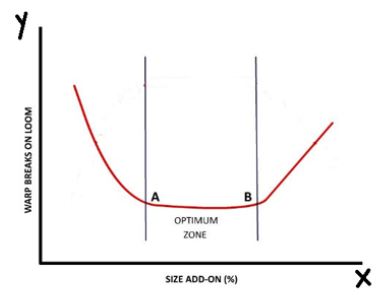
Initially, the warp breaks lessen as the size add-on level increases. This is due to the increased yarn strength and decreased yarn hairiness [2]. The application of the protective size layer around the yarn improves abrasion resistance and offers appropriate protection to the yarn’s weak points [10]. With increasing size add-on, the reduction in warp breaking rate approaches a limit beyond which additional size add-on will not result in a meaningful improvement in yarn performance on the loom. When the warp breakage rate is at its lowest, weaving efficiency, which is inversely related to warp yarn end breakage rate, achieves its peak [11]. As seen in the typical curve in Figure 3, the appropriate range of size add-on is generally between points A and B. In fact, increasing the size add-on beyond the optimum has a negative effect on weaving performance because the warp breaks rise [6]. Excessive size addon causes the size to penetrate further into the yarn, making it rigid. Furthermore, an increased size add-on may coat the yarn with a very thick layer of the size that is not suitably attached to the fibers [2]. When compared to the extensibility of the warp yarn, a thick coating of size film may have lesser extensibility. The inflexibility of the yarn and a loosely bonded size film result in size film shedding owing to facile rupturing, rendering the yarn prone to vigorous abrasion action and a greater warp breaking rate [10]. In reality, the best weaving efficiency area consistent with optimal size addon is generally attained by trial and error [12]. Short fibers stick to the yarn surface and tend to cluster balls if sizing is not handled effectively [13].
Methodology
The approach used here is based on several loom settings. It was noticed how the loom settings decrease ball formation on yarn and cloth, and the best settings were computed (Figure 4).
Figure 4:Important loom components and significant abrasion locations.

The following factors were manipulated in this work to observe
their impacts on ball formation.
a) Warp tension
b) Back-rest height (shed asymmetry)
c) Effect of dropper height
d) Heald wire settings
e) Position of easing arm
f) Change in reed count
g) Effect of changing shed geometry and shed angle
The items listed below were used to carry out the experiment (Table 1).
Table 1:Materials.

Experimental Observation and Discussion
Following features were altered in this study, and their effects on ball formation were explored.
Warp tension
Low warp tension during fabric manufacturing produces stickiness, which causes an unclear route for the filling. While high tension causes yarn breakage, low tension does not [14]. Consistent and uniform warp tension over the width of the warp during the weaving operation was maintained. Identifying and managing the optimal warp tension increased weaving efficiency and fabric quality (Figure 5).
Figure 5:Adjustment of backrest position and height.
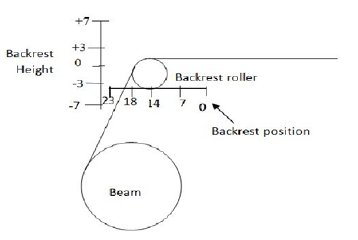
Backrest height
The Backrest roller is an important component of the weaving machine. Several looms were examined in order to determine the best backrest tension. The experiment was carried out using an identical set of backrest height, dropper location, and dropper height. The backrest roller was adjusted up and down while the backrest position, dropper position, and height remained unchanged. It was noticed that fabric quality is dependent on the backrest roller’s appropriate adjustment.
Changing dropper position
The distance between the dropper and the backrest roller is referred to as the dropper position. The dropper line connects the backrest or heald frame horizontally. Dropper depth is determined by the distance between the dropper line and the healed frame (Figure 5). All factors except the dropper position were held constant to evaluate the impact of changing the dropper location. It was learned that appropriate adjustment of this setting is beneficial in eradicating the ball formation problem and improving fabric quality (Figure 6).
Figure 6:Adjustment of dropper position and height.
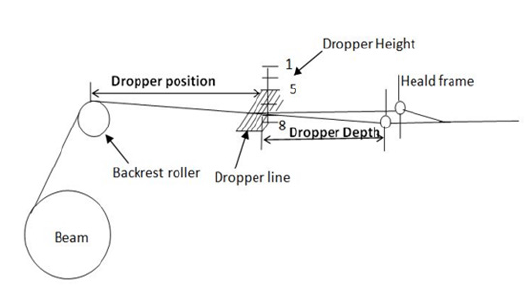
Effect of changing dropper height
The dropper line can be shifted either up or down. The dropper height increases as the dropper line moves upward, and the backrest height decreases as the dropper line moves downward (Figure 7). However, it has been noticed that if the dropper line is situated closer to the heald frame, the influence of the dropper location negates the scenario.
Figure 7:Changing the dropper height.

Effect of using duplex heald wire instead of simplex heald wire (Visual Assessment)
Since duplex two-healed wires have more space between them yarns can travel through them more easily and friction among neighboring yarns is minimized. As a result, the tendency to create balls is diminished.
When comparing samples 1 and 2 of the same fabric structure and yarn count, it is clear that the amount of ball created has been reduced due to the use of duplex heald wire rather than simplex heald wire (Figure 8-11).
Figure 8:Simplex heald wire.

Figure 9:Duplex heald wire.
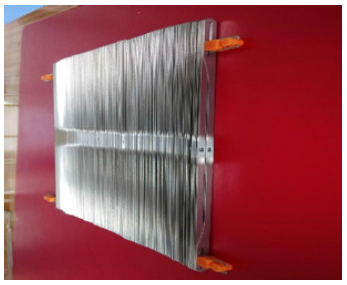
Figure 10:Sample 1-Ball formed in simplex heald wire.
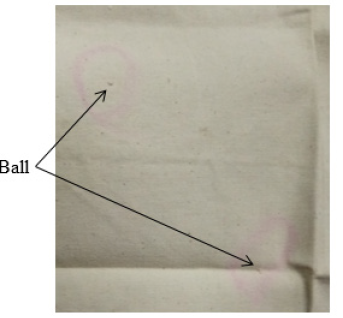
Figure 11:Sample 2-No ball formed in duplex heald wire.
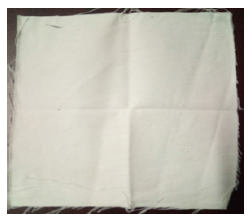
Effect of changing the position of easing arm (Visual Assessment)
Backrest roller bumping might well be enhanced by adjusting the position of the easing arm [15]. It results in greater jerking on the warp yarn. As a result, the short fibers of various yarns come into less touch with each other, and the inclination to create balls is lessened (Figure 12).
Figure 12:Ball not formed due to changing the position of easing arm.
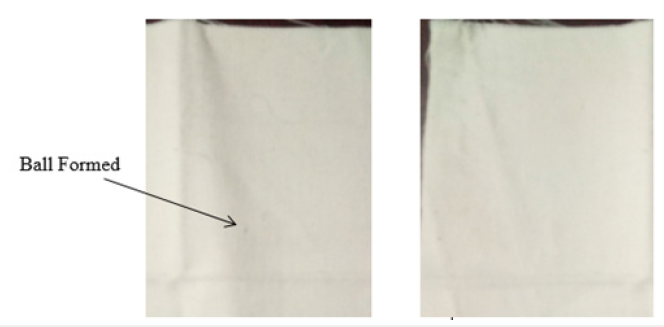
Effect of changing reed count or ends per dent (Visual Assessment)
Reduced reed count or the number of endings per dent in reed dents can also help to minimize yarn friction. As a result, shorthairy fibers do not come into contact with one another, resulting in nearly no fiber balls in the fabric.
Effect of changing shed geometry and shed angle (Visual Assessment)
Backrest roller height and depth with drop wire height may be adjusted to obtain desired shed structure [8]. The shed angle may be controlled by altering the heald frame height. When the shed angle was raised to the optimal amount for the fabric structure and yarn count, warp yarn jamming was reduced. As a consequence, friction was minimized, and ball formation was also reduced (Figure 13).
Figure 13:Less ball formed due to less yarn-to-yarn friction.

Findings
From these observations, it can be inferred that perfect warp tension, proper backrest roller adjustment, dropper location, and dropper height adjustment are the most important aspects in eliminating ball formation and improving fabric quality. Furthermore, using duplex healed wire instead of simplex healed wire can substantially minimize ball formation. Varying the location of the easing arm, changing the reed count or ends per dent, and finally changing the shed design all have a significant influence on reducing friction between yarns in a loom resulting the less possibility of ball formation on fabrics.
Conclusion
However, by adjusting the reed count and heald wire setting, as well as choosing the best shed topology, warp yarn jerking may be enhanced, resulting in extra size materials being detached from the yarn and a reduction in ball formation on the fabric. In order to undertake a quantitative study of the observations on how the remedial activities are fulfilling the weaving section, the subsequent line of research will require a statistical approach with an adequate sample strategy. This study will provide textile specialists with a thorough grasp of the reasons for ball formation on fabric, as well as a conceptual understanding of how to resolve the issue.
References
- Marks R, Robinson ATC (1976) Principles of weaving. Textile Institute, Manchester, UK, pp: 249-249.
- Goswami BC, Anandjiwala RD, Hall D (2004) Textile sizing. CRC Press.
- Brorens PH, Lappage J, Bedford J, Ranford SL (1990) Studies on the abrasion-resistance of weaving yarns. Journal of the Textile Institute 81(2): 126-134.
- Aggarwal SK, Balasubramanian G (1986) Effect of stretch on frequency distribution of breaking elongation of sized ’Yarns and their weavability. Indian Journal of Textile Research 11(3): 146-149.
- Dolecki SK (1974) 9-THE causes of warp breaks in the weaving of spun yarns. The Journal of The Textile Institute 65(2): 68-74.
- Hari PK, Subramanian TA, Aggarwal SK (2013) Weavability-dependence on yarn quality and sizing. Food and Agriculure Organization of the United States 18(2): 16-24.
- Gandhi KL (2019) Woven textiles principles, developments and applications. Woodhead Publishing Series in Textiles.
- Ahmed S, Alimuzzaman S, Monjurul Haque AKM (2020) Effect of shed geometry on starting mark of woven fabric. SN Applied Sciences 2(4).
- Seboka N (2020) Regression model development for showing relation between mechanical yarn stretch (%) in sizing and Warp yarn breakage (cmpx) in looms using ANOVA model. Ethiopian Journal of Textile and Apparel 1(2).
- Heap V, Bradford BA (1988) The correlation between abrasion resistance and weavability of sizing warps. Melliand Textilberichte 69(1).
- Adanur S (2001) Handbook of weaving. Technomic Publishing Company Inc, Lancaster, Pennsylvania, USA.
- Saville BP (2002) Physical testing of textiles. Woodhead Publishing Limited, Sawston, UK.
- Greenwood K (1975) Weaving: control of fabric structure. Merrow Publishing, pp. 12-14.
- Weinsdorfer H, Wolfrum J, Stark U (1991) The distribution of the warp end tension over the warp width and how it is influenced by the weaving machine setting. Melliand Textilberichte 72(11): 360-362.
- Osthus T, Wulfhorst B, Lanvermann G (1995) Automated setting of backrest and drop-wires in mill trial. Melliand Textilberichte International Textile Reports 76: 207.
© 2022 Taposh Ranjan Sarker. This is an open access article distributed under the terms of the Creative Commons Attribution License , which permits unrestricted use, distribution, and build upon your work non-commercially.
 a Creative Commons Attribution 4.0 International License. Based on a work at www.crimsonpublishers.com.
Best viewed in
a Creative Commons Attribution 4.0 International License. Based on a work at www.crimsonpublishers.com.
Best viewed in 







.jpg)






























 Editorial Board Registrations
Editorial Board Registrations Submit your Article
Submit your Article Refer a Friend
Refer a Friend Advertise With Us
Advertise With Us
.jpg)






.jpg)













.bmp)
.jpg)
.png)
.jpg)














.png)

.png)



.png)






